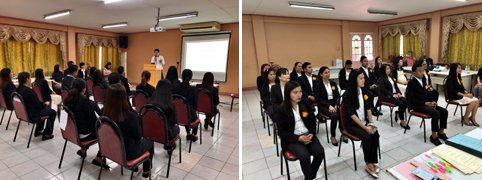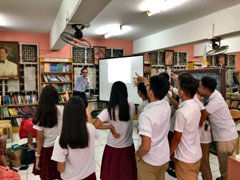Cebu’s Japanese-Language Education is Supported and Expanded by the People of Cebu
The Japan Foundation, Manila (Cebu)
SHINTANI Chika
The Graduation Ceremony is Upon Us
In March 2019 we sent off the first graduates of the Course on Japan for Secondary School Classroom Instructions (hereinafter “CJH”) teachers’ training program since it began being held in Cebu. This training program takes place over a period of three years, and centers on teaching-material analysis and practice lessons aimed at making the participants capable of teaching “enTree ‐Halina! Be a NIHONGOJIN!!‐,” (hereinafter “entrée”) which is teaching material designed for Philippine secondary educational institutions. This fourth batch of students who graduated were also the batch that used “Marugoto: Japanese Language and Culture” as teaching material in the Philippine’s CJH for the first time. We capitalized on what we had learned from the training programs that we had run up to now, and placed an emphasis on boosting participants’ Japanese-language ability. And in the third year of training in particular, we dedicated a lot of time to practice. As a result, along with holding classes founded on a solid understanding of the enTree concept, we added other arrangements such as introducing additional vocabulary, and proactively encouraging the use of hiragana even when the vocabulary in the lesson plan used Romanization. This has given rise to classes that are constantly challenging and which neither the teachers nor the students grow tired of, and the Japanese-language classes are more enlivened than they had been up to now. Furthermore, around half the graduates are taking part in the training of the fifth batch of students, which began from April 2019, as instructors. The secondary education teachers’ network in the Visayas region, centering on Cebu, is gradually strengthening as classes that developed based not only on the knowledge passed on from senior teachers to their more junior colleagues, but also thanks to the experiences that only senior teachers can convey.

Graduation ceremony held in Cebu
Let’s Teach Survival Japanese Using an Action-Centered Approach!
The “2018 Japanese-Language Teaching Method Training: Let’s Teach Survival Japanese Using an Action-Centered Approach!” which was hosted by the ANT-V (Association of Nihongo Teachers in Visayas), was held over a two-day period in Cebu City. On the first day, participants learned about the action-centered approach, and following that, workshops were held in which situations were set up that replicated problems encountered in day-to-day life. The participants considered the vocabulary and expressions needed to resolve those problems, constructed conversations, and held practice lessons in the form of poster sessions. On the second day, participants considered how to evaluate those lessons, came up with rubrics, and thought about ways of implementing role-playing tests. The training attracted participation not just from Cebu but also from locations farther afield such as Manila, Cagayan de Oro and Bacolod. The participants found the training very satisfying, to the extent that the individuals who were attending from other regions said they want the ANT-V to hold similar events in their regions. The training also proved to be a valuable opportunity for Filipino Japanese-language teachers who are active in other regions to come together and exchange information.
“Nihongojin” Seminars
At high schools in the Visayas region that teach the Japanese language, there is an event known as the “Company Caravan,” which involves visiting Japanese companies in Cebu. However, due to a variety of circumstances, there are also some schools where it is not possible to hold events that involve the students venturing outside their schools. Out of consideration for schools like this, we planned and held career education seminars called “Nihongojin Seminars,” where we invited “Nihongojin” – people who work in Cebu and use the Japanese language in their work – to the schools as lecturers.

An activity held during the seminar
In the latest such event, we had a Filipino who works as a bridge engineer for an IT company present a seminar on “Utilizing the Japanese language at IT companies.” Among high school students studying the Japanese language, I occasionally encounter students whose idea of using the Japanese language ends up being confined to the classroom – some of them end up drifting away from the Japanese language due to their interest in PCs or programming, while others continue to study Japanese without being able to picture how they might be able to use it in the future. For high school students such as this, the seminars have become valuable opportunities for learning about the existence of jobs that can be secured by having a special skill combined with the Japanese language, and about how the language is actually being used at companies in the Philippines. At the end of the seminar, a lively question-and-answer session took place, and it was clear that the students’ interest had been piqued. These seminars also promise to have a significant impact in terms of improving students’ motivation to learn the Japanese language.
- What We Do Top
- Arts and Cultural Exchange [Culture]
- Japanese-Language Education Overseas [Language]
- Japanese-Language Education Overseas [Language] Top
- Learn Japanese-language
- Teach Japanese-language
- Take Japanese-Language Test
- Know about Japanese-language education abroad
- The Japanese-Language Institute, Urawa
- The Japanese-Language Institute, Kansai
- Japanese-Language Programs for Foreign Specified Skilled Worker Candidates
- Japanese Language Education for Japanese Children Resident Overseas and for the Descendants of Migrants
- Archives
- Japanese Studies and Global Partnerships [Dialogue]
- JF digital collection
- Other Programs / Programs to Commemorate Exchange Year
- Awards and Prizes
- Publications
